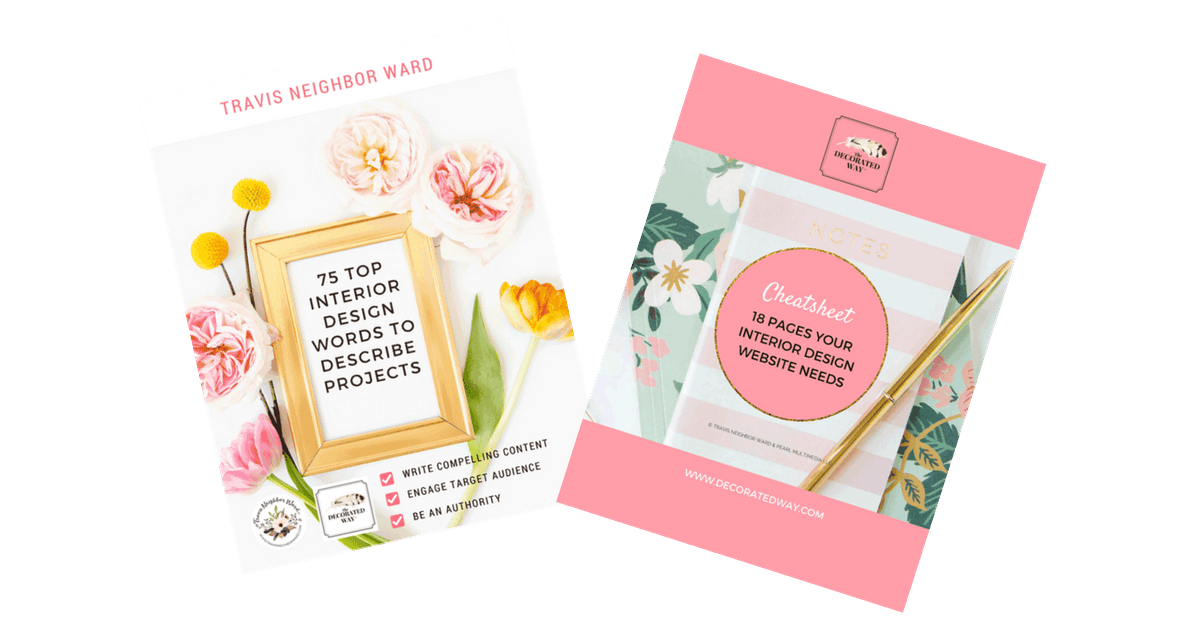Understanding how to find interior design clients is definitely one of the biggest challenges you’ll have as a designer–at least until you’re well-established. And while in-person meetings and word-of-mouth is the age-old strategy, there’s a lot to be said for reaching out to homeowners online. They, too, are your potential clients and if they like what you’re sharing, chances are they’ll share it with others.

>>Affiliate notice: Some of the links here may be affiliate links.
Bottom line: Use your blog and website, and social media, for more than just showcasing your portfolio. Use them to establish you as a design authority.
When you’re viewed as an authority, chances are higher that new clients will come knocking on your door.
So how do you find interior design clients online?
The key to finding them is to engage with them on their turf. it also means communicating your ideas in a creative, compelling, and clear way.
If that intimidates you because you’re not a writer or editor, don’t let it! Engaging an audience can mean producing original content, such as design-oriented blog and social media posts, but it doesn’t have to. You can also engage people by sharing your ideas in response to content or photos that you didn’t publish.
Your goal with online engagement is to help people know you and trust you. And there’s no better way to do that than by sharing your opinions and knowledge with them.
Note: Engaging is about you, the real person
Note that I said “you” and not “your accomplishments.” Too often I see interior designers turning their online posts into blatant self-promotion, either of themselves or their firm. That can get annoying to others and it will work against you.
Also, I think it can come across as outdated because it’s an old school approach to marketing. The new school approach is to think more like an editor — in other words, like someone whose job is to share the best information they have.
Engaging is about being yourself and sharing your amazing wisdom and ideas with others. It’s not about advertising. It’s about being authentic!

Why is engaging with an audience worth your time?
Here are some other good reasons:
1. Word of mouth referrals are essential in design fields. People are more likely to refer you to someone, and hire you, if they are personally familiar with you.
>> JOIN THE HOUSE PUBLISHING CLUB
2. There’s so much competition for work, and a lot of the interior designers you’re competing against are extremely talented. Engaging actively with your audience online gives you a big advantage over the many interior designers who don’t.
It’s one more sign that tells potential clients you’re a person that goes the extra mile for others.
3. People often like to “follow” people who actively engage on social media. Often if someone follows you on one platform, like Instagram, they’ll also follow you on others.
4. Blog, magazine, and TV editors seek out designers who are good at engaging. As a former magazine editor-in-chief, I assure you that we are always on the lookout for professionals who can give us good quotes, projects, and ideas.
The more you engage, the better you will get at it — and the more chance that editors will see you as an interior designer that people will want to listen to. In this case a lot of it comes down to delivering the perfect pitch letter.
It also comes down to having project information ready that’s geared specifically towards getting published.
5. Your comments on other people’s websites can help you rank higher on search engines. When I search for myself on Google, a bunch of comments I’ve left on websites and social media pop up among the articles I’ve published.
To do this, you should create a Gravatar, or photo of you that pops up whenever you comment anywhere on the Internet.
The best things you can do to find interior design clients online via engagement:
1. Answer people’s questions on social media forums
As a designer you’re an expert on tons of topics. Use that expertise to help people find the answers they seek. To make it targeted, identify first where your ideal clients hang out online and go there. For instance, if you’re after women who live in cities and love interior design, you may want to search for Facebook communities that revolve around that. Or, if you’re after real estate developers for new architecture projects, LinkedIn communities may be a better bet. Do your homework so you don’t waste your time.
2. Respond to people’s comments on your blog
At the end of every blog post you should have a call to action—that means a sentence that encourages people to leave comments. Make sure that you reply to people after they’ve left a comment. This lets them know you’re listening and care. That’s also a good chance to plug your work. For example, you can answer their question by linking to something else you wrote or a project you published. Keep the focus on helping them and they’ll love it.
3. Participate in group discussions online
Quora is a fantastic place to find discussions that crop up around questions. I answered a question on Quora and more than 10,000 people viewed it in the first few weeks! I also got hundreds of comments on my answer. I turned around and replied to each person. In some cases my replies led to a discussion.
This can also happen on LinkedIn, Facebook, and Google Plus communities, or on blogs and media websites. If you think a particular design magazine has published a good article online, leave a comment on it, or comment on someone else’s comment.
Whenever you can, link to your website in your bio. Just don’t use the comments to advertise yourself; that will make you look like a spammer.
4. Tell a story
People love stories, and you can engage people by sharing yours in response to a common theme. So for example if you’re on someone’s design blog and they wrote about a story that happened to them, you can engage by sharing a related story that happened to you. Keep it short enough so that you don’t overwhelm their post. But make it interesting so people will want to jump over to your blog or website after, to find out more about you. And if you’ve written a design book, make sure to promote it using book-related Twitter hashtags, as well as book publicity strategies.
5. Be funny
Humor goes a long way online. People can’t get enough of it. Just beware that some people frown on sarcastic and snarky humor because it can sound offensive in writing. If that’s your style, make sure your audience is open to it. You don’t want to engage them negatively by accident!
6. Be compassionate and empathetic
Put yourself in someone else’s shoes. Consider how they feel. Write a reply that will actually matter to them. Share something you’ve gone through that’s similar. In other words, help your target audience relate to you as you relate to it.
For example: If someone is complaining about how tiny their bedroom is and they don’t know how to make it seem larger, tell them about a small bedroom you once had. Then offer your professional tips about easy ways they can improve theirs. Or, write a blog post on the topic, like this blog post I wrote.
7. Make your case, but be open to others
I can’t stand it when people use online forums to show off their intelligence (or worse, to insult others). On the flip side, I get bored with people who don’t take a stand on anything. It’s exciting when people have opposing views and they can hash them out together online. But that’s different from coming across as someone who thinks he knows so much more.
Your online debate with others should be healthy, not harmful. A good place to find debates is on the websites of local newspapers. If the topic is timely, chances are more people will be participating and interested. Plus, lots of potential clients may be reading it.
8. Share links for more information
Your tendency might be to link only to your own website or blog when you engage with an audience. But that’s a mistake. Your goal is to have people see you as a helpful authority, or what I call a Very Helpful Designer. So if that means linking to someone else’s site, do it! I’m not saying you should link to a direct competitor’s site. But you can always link to a major media site or a design blog.
Design bloggers will really appreciate the publicity, so let them know when you link to their sites. It can also be a good time for you to pitch yourself to them as an interior designer whose work they might feature, or as a good interview source.
9. Don’t rule out any potential platforms without checking them out first
I remember thinking that Twitter wouldn’t help me when I was building my website. To me Twitter seemed like one long, useless feed of short sentences. I didn’t understand back then how targeted you can get with Twitter audiences. You can build lists of followers that you know are interested in your industry. Then, when you Tweet a link to your blog post, you can target them by adding their Twitter handle or a hashtag. Often Tweets can lead to discussions.
10. Engage at the right times—for you and your target audience
It’s too easy to get sucked into engaging with people online too much. You can “go down the rabbit hole” in forums and groups without realizing that you’ve just spent as hour writing comments when you only planned to spend 10 minutes. That’s not good for business.
Before you get in this habit, take a look at your weekly schedule and figure out how much time you can spend engaging with people online. It may be three hours a week; it may be 30 minutes. Whatever it is, write it on your schedule and stick to it. That way you’ll know that you’re definitely doing it and you won’t be constantly trying to fit it in (or doing it too much).
Also, find out the best times when your target audience is online. There are lots of studies on the Internet about when people are more likely to share or comment on things. Often it centers around early evening and weekends, when people have more free time. But it varies from platform to platform.


